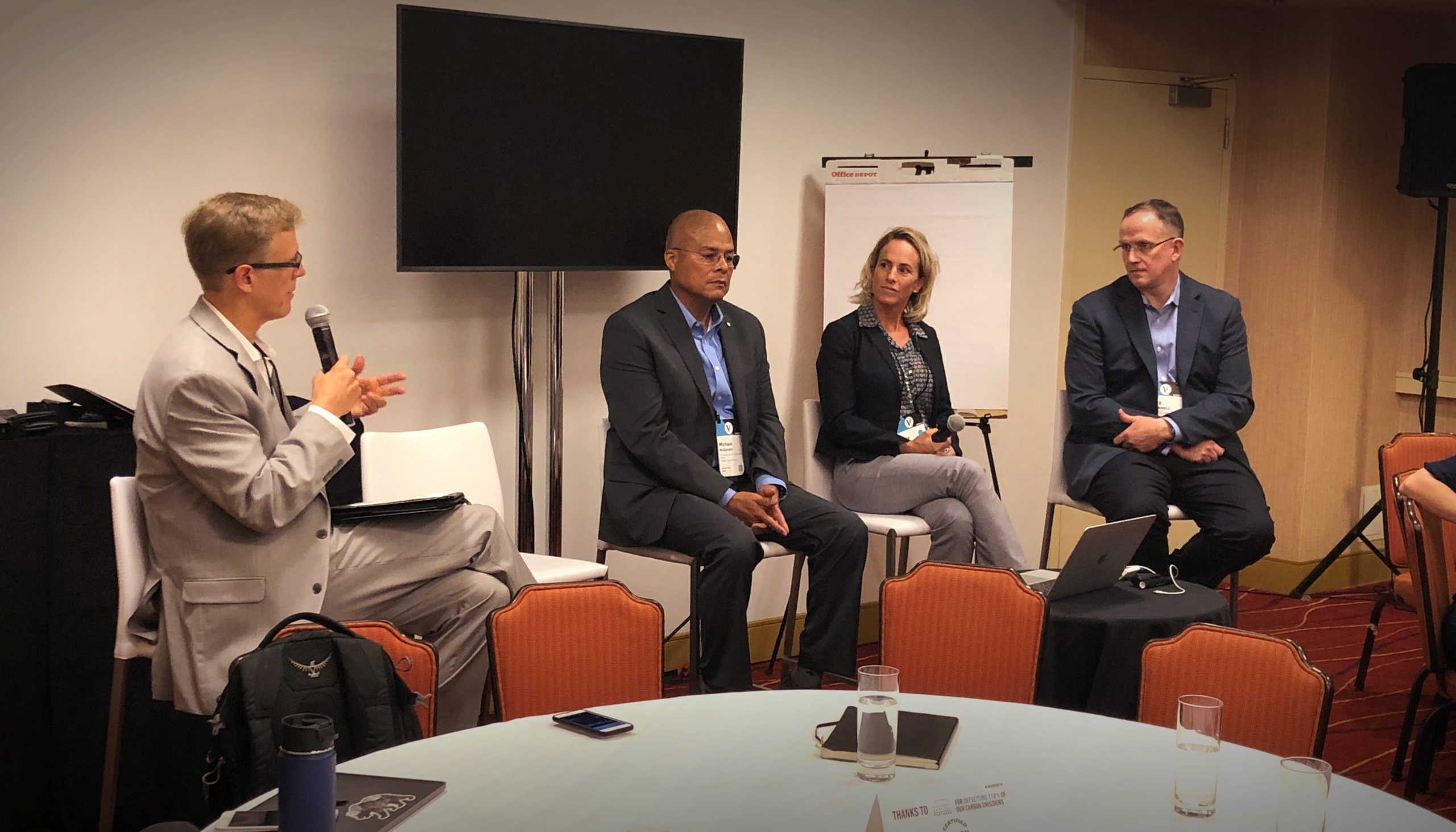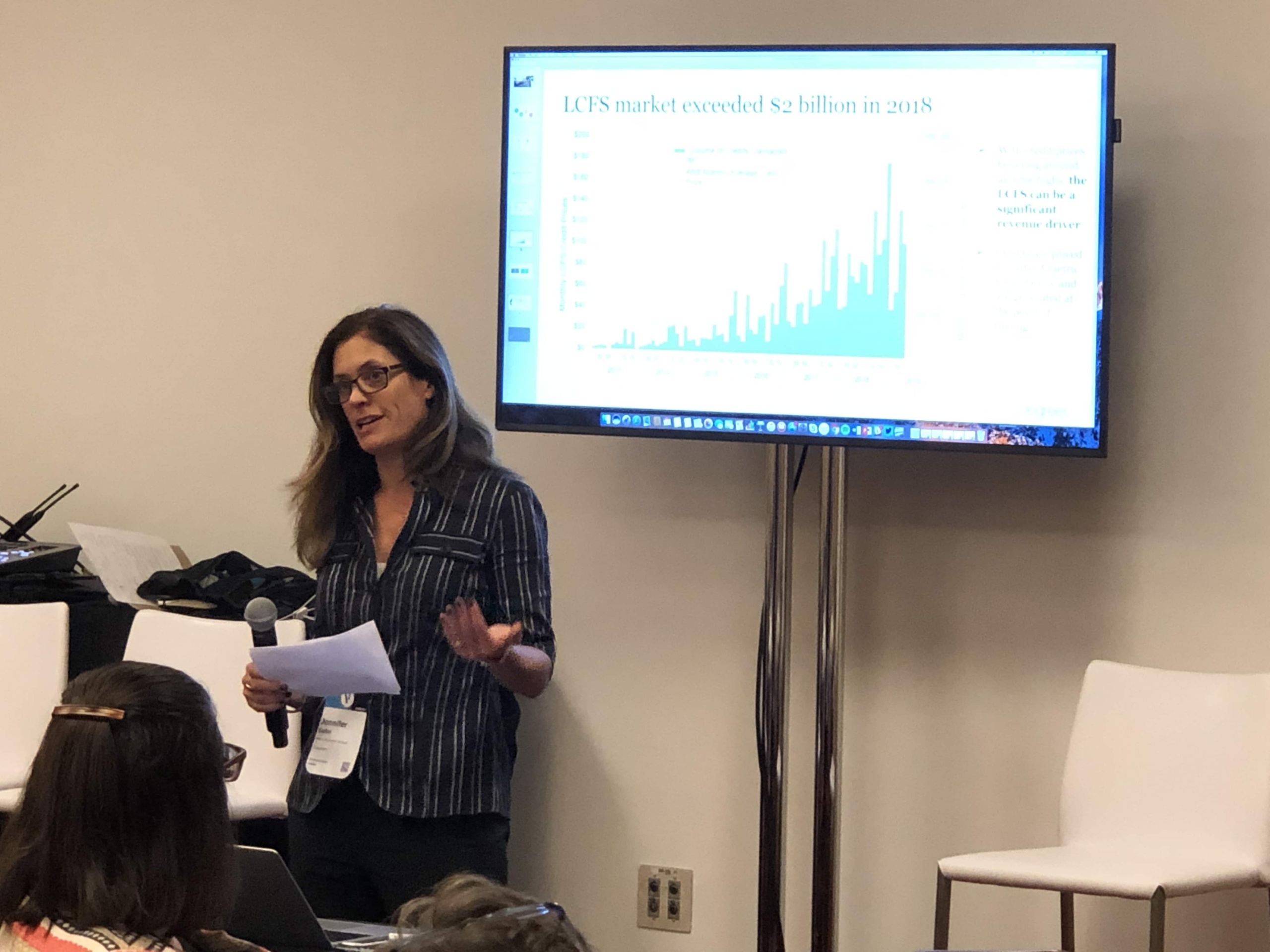Last week, I was part of the Low-Carbon and EV Fleet workshop at VERGE 19. Katie Fehrenbacher from GreenBiz did a great job bringing together thought leaders across business and policy to dive into the opportunities and challenges around decarbonizing transportation.
Real world fleet transition challenges
I had the opportunity to moderate a panel with three leaders who manage their organizations’ fleet transitions: Julie Johnson, National Business Development-Advanced Vehicle Techs, Ryder System, Inc.; Michael McDonald, Director of Maintenance and Engineering for Sustainability and Government Affairs, UPS; and Mike O’Connell, Vice President of Supply Chain, PepsiCo.

Steve McDougal with panelists (L to R): Michael McDonald, Julie Johnson, and Mike O’Connell
The panelists were candid about the challenges of overall vehicle reliability — even as the technology for low-carbon and EV fleets continues to make significant progress. While all the panelists value reliability, it presents a different degree of risk to their respective business models. Case in point: Mike O’Connell noted that PepsiCo’s vehicles deliver and restock its distributors’ inventory. However, even if there’s an issue that delays the vehicle, consumers will likely still be able to get their drinks and chips. In contrast, if/when UPS experiences an issue with vehicle reliability, customers don’t get their packages. Similarly, Ryder’s customers expect reliable uptime when they lease fleets from the company. There is no back-up inventory for the delivery of packages or uptime of leased vehicles.
Perhaps it’s not surprising that each panelist emphasized the diversity of their fleets’ alternative fuel portfolio to include both alternative fuels and EVs. Maintaining fuel diversity has been an important approach to mitigate the challenge of reliability. Consider that UPS has announced plans to add more than 6,000 compressed natural gas (CNG) trucks that can run on both renewable natural gas (RNG) and conventional natural gas. Given these plans, UPS is the largest consumer of RNG in the transportation industry.
And the potential impact is significant: RNG yields up to a 90 percent reduction in lifecycle greenhouse gas emissions when compared to conventional diesel, as noted by UPS.
Scalability was another theme as these panelists shared insights from their experiences in managing fleet transitions. Their vision is to move beyond demonstration projects and pilots. Mike O’Connell from PepsiCo shared, “We can all do five or ten of something but it doesn’t make sense unless it can scale to 100 or more.” And the panelists noted that it can take time to build up infrastructure and vehicles for these other fueling options.
The role of market-based incentives in accelerating the transition

Jennifer Cohn with 3Degrees, speaking about incentives to transition to low-carbon fleets
In another session, my colleague Jennifer Cohn provided an overview of “How Incentives Can Accelerate the Transition to Low-Carbon Fleets.” She focused on the low-carbon fuel standard (LCFS) as a key example of an important market-based instrument that organizations can leverage. This program is relevant for anyone operating fleets in California, Oregon, and/or British Columbia — particularly organizations with electric vehicles in their fleets or charging infrastructure on their campuses.
Run by the California Air Resources Board (CARB), the LCFS aims to reduce the carbon intensity of California’s transportation fuel pool. LCFS is based on life-cycle emissions of the fuel — from production to consumption. The lower the carbon intensity of alternative fuels — ethanol, bio-diesel, electricity, etc. — the more LCFS credits can be generated. While EVs may have zero tailpipe emissions, you can make the inputs greener by purchasing renewable energy certificates (RECs) to match charging output.
The total value of LCFS credit transactions exceeded $2 billion in 2018. Credit prices are driven by market supply/demand and have been historically volatile — but they are now at an all-time high of ~$200 per credit. As these are “market-based” incentives, there is an element of risk that is important to manage. 3Degrees advises our clients on this and sometimes even hedges that risk on their behalf.
An interesting finding – when Jennifer asked the workshop attendees who had heard of LCFS, almost every hand in the room went up. But when she asked who was actually taking advantage of the LCFS program, only two hands remained.
The takeaway? Many organizations are leaving significant money on the table — and also have an opportunity to make an even larger impact on the decarbonization of transportation.
I look forward to seeing many more businesses make greater headway here in the near future, for their own benefit — and that of the climate.


